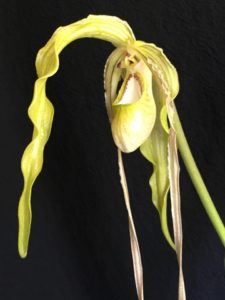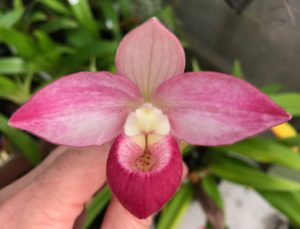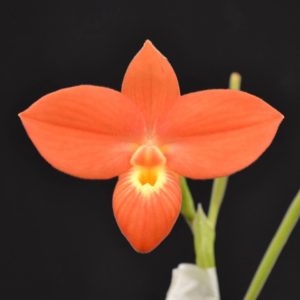Phragmipedium Care and Feeding
Phragmipedium are intimidating to many people. Most are actually quite easy to grow as long as you consider their requirements. For that you need an understanding of the habitat where they grow. We are by no means expert growers of Phragmipedium. Our California Central Valley summers make many of these quite challenging for us. After years of trial and error we are able to keep most of the species and hybrids growing and thriving. Here we offer some advice based on that experience. This is by no means a ‘one size fits all’ situation. You may have to learn what works for you.
The Easy Phragmipediums
We are calling this group ‘easy’ because they will grow alongside many other common orchids in your collection. We successfully cultivate these ones with Cattleyas and Oncidiums. This group includes Phragmipedium caudatum and most of its other long petaled relatives as well as Phragmipedium lindleyanum. Many of these Phrags grow at relatively low elevations so they are tolerant of warm temperatures. They will grow well with daytime temperatures in the mid 80’s F and nights in the 60’s.
 Many plants in this group will take very bright light. I once saw a speaker at a conference who had been to the habitat of these species. He had a photo of a Phragmipedium growing up against a Catasetum species in situ. They were in full sun and it was obviously the dry season as the Catasetum had no leaves. What does this tell us? It tells us that this group does not want wet feet, they want good light and good air movement.
Many plants in this group will take very bright light. I once saw a speaker at a conference who had been to the habitat of these species. He had a photo of a Phragmipedium growing up against a Catasetum species in situ. They were in full sun and it was obviously the dry season as the Catasetum had no leaves. What does this tell us? It tells us that this group does not want wet feet, they want good light and good air movement.
We grow these ones in well drained media. We use Orchiata seedling bark with about #3 perlite mixed in…about 1/3 of the mix. They get watered once per week most of the year…sometimes a bit less in the cooler months and sometimes a bit more when it’s really hot. We fertilize at every watering with a complete fertilizer that adds micronutrients as well as basic nitrogen, phosphorus and potassium. These seem tolerant of high fertilizer rates, but we choose to flush them with pure water from time to time. Bright light is ideal, but we don’t recommend direct sun. These will do just fine in moderate light alongside your complex or mottled leaf Paphiopedilum.
The Common Hybrids
It is difficult to lump all of the Phragmipedium hybrids you see into one group, but most modern breeding has become fairly complex. These hybrids usually contain some combination of the most common species like Phragmipedium besseae, kovachii, schlimii and its relatives, longifolium and sargentianum.
 Unless you are dealing with a hybrid made exclusively with cooler growing species (see the next section), these will be fairly hardy and tolerant of a good range of conditions. Breeders use parents like Phragmipedium schlimii to create more compact growing plants, but also to take advantage of their heat tolerance. Most of the commonly seen hybrids will appreciate intermediate temperatures. We recommend low 80’s for daytime and low 60’s at night. Humidity is important for this group. If you are able to maintain 60% to 70% humidity the plants will perform very well. Humidity trays and misting systems will help with this. Air movement is also very important. This helps prevent disease from developing.
Unless you are dealing with a hybrid made exclusively with cooler growing species (see the next section), these will be fairly hardy and tolerant of a good range of conditions. Breeders use parents like Phragmipedium schlimii to create more compact growing plants, but also to take advantage of their heat tolerance. Most of the commonly seen hybrids will appreciate intermediate temperatures. We recommend low 80’s for daytime and low 60’s at night. Humidity is important for this group. If you are able to maintain 60% to 70% humidity the plants will perform very well. Humidity trays and misting systems will help with this. Air movement is also very important. This helps prevent disease from developing.
We have been successful with Orchiata Precision grade bark mixed with about 30% of #3 perlite. This mix holds moisture well but also allows for air at the roots. We water frequently, especially in the warmer months. Every other day is common in the summer. In the winter we will water twice a week in order to draw air into the mix to keep it fresh. If possible, try to just get water to the pot and avoid the foliage. This is especially important in the cooler months when the leaves will not dry quickly. Always flush the put thoroughly with water in order to draw air into the mix and flush out mineral buildup. We fertilize at a high rate of 125 ppm nitrogen, but flush the plants with pure water an hour after we fertilize. You can opt for a weak fertilizer application of a 1/4 rate and forgo the flushing.
Many of the species that make up these hybrids come from habitats where water is moving by their roots. Even when it is not raining water is seeping from higher ground and slowly trickling over the roots. There are people who have tried to make ebb and flow systems to mimic this in their greenhouses. I have heard of mixed results. If the water is kept fresh and the roots are not submersed completely this could be an ideal situation. We have not tried this.
The Cool Growers
This is the challenging group for most of us. They include species like Phragmipedium besseae and kovachii. These species come from high elevations where daytime temperatures do not get much past 80 F. They are not tolerant of much heat and require high humidity.
 We have had good luck with these in the last few years. This of course comes after over a decade of killing high quality (and high $$$) Phragmipedium besseae. We try to keep the greenhouse in the low 80’s even in our hottest months. Good air movement is critical. We use a misting system under the bench to help maintain humidity. This is supplemented with overhead misting on the hottest, driest days. Overhead misting must be used with caution, as you do not want to we the foliage and encourage disease.
We have had good luck with these in the last few years. This of course comes after over a decade of killing high quality (and high $$$) Phragmipedium besseae. We try to keep the greenhouse in the low 80’s even in our hottest months. Good air movement is critical. We use a misting system under the bench to help maintain humidity. This is supplemented with overhead misting on the hottest, driest days. Overhead misting must be used with caution, as you do not want to we the foliage and encourage disease.
We water this group every 2 to 3 days in the warmer months. We don’t worry about wetting the foliage as we water early and the leaves dry quickly, but ideally you would focus the water on the pot. Fertilizer is applied once per week at 125 ppm nitrogen. This is quite strong for this group but we flush the pots with pure water within an hour. Water quality is critical for these plants. They do not tolerate mineral buildup in the mix.
These plants are potted in Precision Orchiata with about 30% of #3 perlite. This mix holds moisture but allows for air in the pot. For Phragmipedium kovachii we use the Classic grade of Orchiata as the plants are larger and we add about 5% oyster shells to the mix. This species seems to appreciate the higher pH in the mix that results from the oyster shells. Mature kovachii should have an even larger grade bark as they require very large pots.
